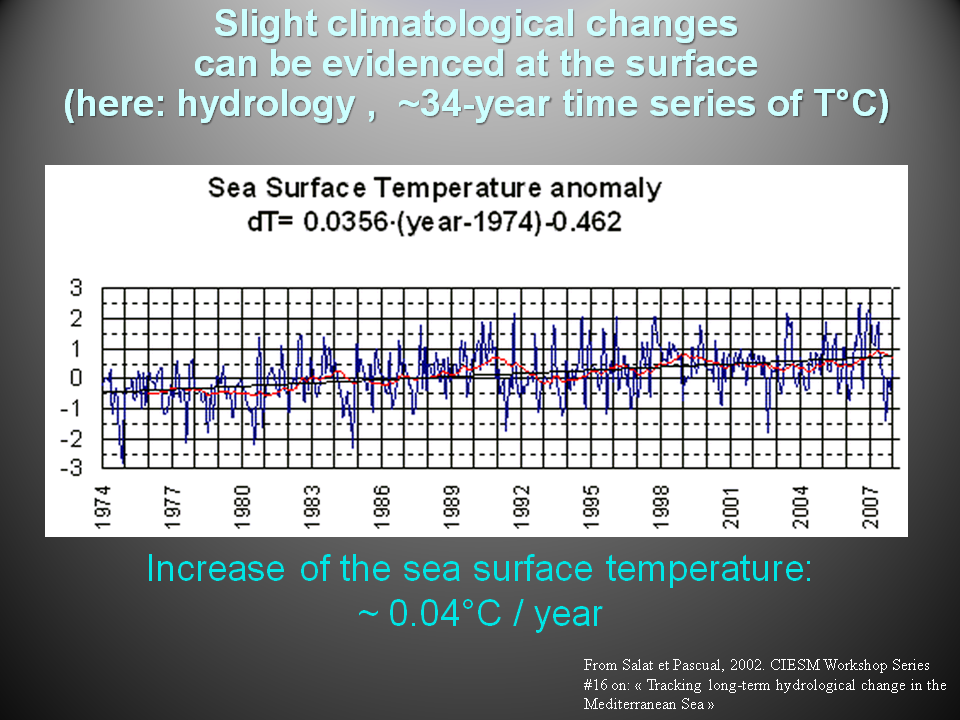|
Project Summary: TRANSMED aims, in fine,
at developing a network for monitoring the surface of the
Mediterranean, using ships of opportunity. Indeed it is possible
to record variability (potentially related to climatic changes) from
surface parameters, as shown from NW Spain coastal area data
(Figure 1; see also the Hydro-Changes program). 
Figure 1: 34-year record of the surface temperature near the islas Medes (NW Spain). Update courtesy Jordi Salat Figure
2 represents such an
optimal network, based on existing/actual shipping lines. It includes
routes crossing the whole basins, sampling the dense water formation
areas, and investigating poorly-known areas. Ferries are especially
adequate, since they allow building time series with a relatively high
temporal scale. Thus it is generally possible to correctly describe the
mesoscale, which is present everywhere in the Mediterranean. Moreover a
network allows a (quasi)synoptic view at the basin scale. Usually
sub-sampled data are sent in real time (via Inmarsat), and contribute
to operational oceanography.
The basic equipment is a thermosalinometer, which records the
hydrological (temperature and salinity) parameters. Other instruments
such as fluorometers (for phytoplankton chlorophyll determination) and
biogeochemical sensors (for dissolved oxygen, pCO2, nutrients…) can
also be added, possibly completed by a meteorological station.
As a pilot phase, a SeaKeepers Module (thermosalinometer plus
meteorological station) and a fluorometer
were installed on the SNCM car-ferry
“Mediterranee”, which crosses the whole western basin from Marseilles
to Algeria and Tunisia, approximately once per week (Figure 3).
The figure 4 illustrates the results obtained during the
summer 2006 on the Mareilles- Tunis line: positive anomaly of
temperature in July, negative in August in the northern part of the
basin. More importantly it shows the very fast response to the setting
of the mistral wind late July in the Gulf of Lions: the temperature
drops by 3-5°C within ~24 hours (upwelling). NB: mention here the work done on the Cetacean observations? Thesis Cedric Cotté The need/necessity to have an open, versatile and really autonomous system
that would be simple and cheap appeared rapidly. The CIESM
fostered the development of such a prototype, realized by the Division
Technique de l'iNSU (http://www.dt.insu.cnrs.fr/ ) (Figure 5). Tests
were conducted on the french RV "Tethys 2", after the main functions of
autonomy were implemented (commands of the pump, data acquisition and
transmission). The TRANSMED protype was in piggyback with the main
thermosalinometer installation: it performed as expected and
satisfactorily (Figure 6-Figure 7). The final development of the TRANSMED
system is presently stalled due to the lack of technical help. In
the future the idea is to have part of the ships equiped with the basic
(cost-efficient) TRANSMED system (SBE45-based), for instance when there
is no visibility on the route they are assigned to, or when maintenance
is not expected to be easy , and to have the other part of the ships
equipped with an improved TRANSMED system (SBE21-based), that can
accept additional sensors for multidisciplinarity.
|



